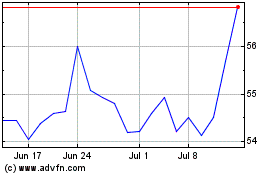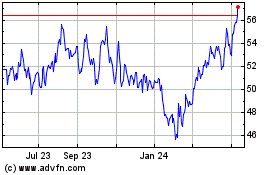National Fuel Gas Supply Corporation (“Supply”) and Empire
Pipeline, Inc. (“Empire”), the operating companies that make up the
Pipeline and Storage segment of National Fuel Gas Company (NYSE:
NFG) (“National Fuel”), have announced the beginning of two Open
Seasons, making firm transportation capacity available from the
Marcellus Shale formation in the central and southwestern producing
regions of Pennsylvania.
“We are pleased to continue to offer the necessary pipeline
infrastructure and transportation services so vitally needed by the
companies producing natural gas from the Marcellus Shale
formation,” said Ronald J. Tanski, National Fuel’s President and
Chief Operating Officer. “Empire’s Tioga County Extension projects
will help meet the demands of Marcellus producers in central and
eastern Pennsylvania by providing significant additional capacity
out of the area to high value markets in New England, Canada and at
the Dawn hub. The continued enhancement of Supply’s existing
infrastructure in southwestern Pennsylvania provides a unique
opportunity to serve those Marcellus producers by moving their
production to the expanding east coast and mid-Atlantic markets. We
are confident that both projects will be well-received and look
forward to developing these projects to better serve
customers.”
Empire’s Open Season 008 offers capacity in Empire’s Tioga
County Extension Phase 2 Project (“TCE2”), which is being designed
to provide approximately 260,000 Dth per day of incremental firm
transportation from producer interconnections in Pennsylvania’s
Bradford and Tioga counties, as well as from prospective
interconnections with the Tennessee Gas Pipeline (“TGP”) 300 Line
and the proposed Penn Virginia Resources Midstream (“PVR”) pipeline
in Tioga and Lycoming counties. This transportation capacity would
provide access to diverse markets at several Empire delivery
points, including Empire’s existing interconnection with
TransCanada Pipeline at Chippawa, its planned interconnection with
the TGP 200 Line near Rochester, New York, and its existing
interconnection with Millennium Pipeline at Corning, New York.
The TCE2 project facilities would include two new compressor
stations, approximately 25 miles of 24-inch or 30-inch
high-pressure pipeline, and other enhancements along Empire’s
existing system. The new high-pressure pipeline would begin at a
new interconnection with the TGP 300 Line and/or an interconnection
with the proposed PVR pipeline, and would extend north to Jackson
Township, Pennsylvania, where it would connect with the 24-inch
pipeline that Empire expects to construct in 2011 as part of its
previously announced Tioga County Extension Phase 1 Project
(“TCE1”). TCE1, which was the subject of Empire Open Season 006, is
being designed to provide 350,000 Dth per day of incremental
transportation capacity from Jackson Township, Pennsylvania, to
Empire’s interconnect with TransCanada Pipeline at Chippawa. Empire
filed its FERC 7(c) application for the TCE1 project on August 26,
2010, and service is expected to commence September 1, 2011. Empire
has executed precedent agreements with anchor shippers Shell Energy
North America (US) L.P., and Talisman Energy USA Inc., and the
capacity is fully subscribed.
Depending on final facility design and Open Season awards, TCE2
would also provide significant short-haul capacity from the
Pennsylvania producing area to Millennium Pipeline at Corning, New
York. Empire expects that TCE2 could be placed in service as early
as September 1, 2013.
Supply’s Open Season 167 offers an additional 45,000 Dth per day
of transportation capacity in conjunction with its previously
announced Line N Phase II expansion project. The final facility
design has made this additional capacity available, from receipt
points at new and existing producer interconnects along Supply’s
Line N system in Pennsylvania’s Greene, Washington and Beaver
counties to a delivery point at Supply’s proposed interconnection
with Texas Eastern Transmission Corporation at Holbrook Station in
Greene County, Pennsylvania. Supply’s Line N Phase II facilities
would include additional compression at its Buffalo Station, along
with approximately six miles of pipeline replacement in Washington
County, Pennsylvania. The Line N Phase II project, which would have
a total maximum capacity of 195,000 Dth per day, is currently
supported by Range Resources Appalachia, LLC (“Range”), which has
executed a Precedent Agreement for 150,000 Dth per day.
Supply filed its FERC 7(c) application on June 11, 2010, for the
Line N Phase I expansion project, which is being designed to
provide 160,000 Dth per day of incremental transportation capacity.
This project is fully subscribed and has a projected in-service
date of September 1, 2011.
National Fuel is an integrated energy company with $5.1 billion
in assets comprised of the following four operating segments:
Exploration and Production, Pipeline and Storage, Utility, and
Energy Marketing. Additional information about National Fuel is
available on its website at investor.nationalfuelgas.com or through
its investor information service at 1-800-334-2188.
Certain statements contained herein, including those that are
identified by the use of the words “anticipates,” “estimates,”
“expects,” “forecasts,” “intends,” “plans,” “predicts,” “projects,”
“believes,” “seeks,” “will,” “may” and similar expressions, are
“forward-looking statements” as defined by the Private Securities
Litigation Reform Act of 1995. Forward-looking statements involve
risks and uncertainties, which could cause actual results or
outcomes to differ materially from those expressed in the
forward-looking statements. The Company’s expectations, beliefs and
projections contained herein are expressed in good faith and are
believed to have a reasonable basis, but there can be no assurance
that such expectations, beliefs or projections will result or be
achieved or accomplished. In addition to other factors, the
following are important factors that could cause actual results to
differ materially from those discussed in the forward-looking
statements: financial and economic conditions, including the
availability of credit, and their effect on the Company’s ability
to obtain financing on acceptable terms for working capital,
capital expenditures and other investments; occurrences affecting
the Company’s ability to obtain financing under credit lines or
other credit facilities or through the issuance of commercial
paper, other short-term notes or debt or equity securities,
including any downgrades in the Company’s credit ratings and
changes in interest rates and other capital market conditions;
changes in economic conditions, including global, national or
regional recessions, and their effect on the demand for, and
customers’ ability to pay for, the Company’s products and services;
the creditworthiness or performance of the Company’s key suppliers,
customers and counterparties; economic disruptions or uninsured
losses resulting from terrorist activities, acts of war, major
accidents, fires, hurricanes, other severe weather, or other
natural disasters; changes in the availability and/or price of
natural gas, and the effect of such changes on natural gas
production levels; significant differences between projected and
actual natural gas production levels; uncertainty of natural gas
reserve estimates; inability to obtain or retain sufficient
customers or commitments for planned projects; factors affecting
the Company’s ability to complete expansion projects as planned,
including among others geography, weather conditions, shortages or
unavailability of equipment and services required in construction
operations, unanticipated project delays or changes in project
costs or plans, and the need to obtain governmental approvals and
permits and comply with environmental laws and regulations; changes
in laws and regulations to which the Company is subject, including
energy, environmental, tax, safety and employment laws and
regulations; governmental/regulatory actions, initiatives and
proceedings, including those involving expansion projects,
financings, rate cases, affiliate relationships, industry
structure, and environmental/safety requirements; significant
changes in the Company’s relationship with its employees or
contractors and the potential adverse effects if labor disputes,
grievances or shortages were to occur; or the cost and effects of
legal and administrative claims against the Company. The Company
disclaims any obligation to update any forward-looking statements
to reflect events or circumstances after the date hereof.
National Fuel Gas (NYSE:NFG)
Historical Stock Chart
From Apr 2024 to May 2024

National Fuel Gas (NYSE:NFG)
Historical Stock Chart
From May 2023 to May 2024
